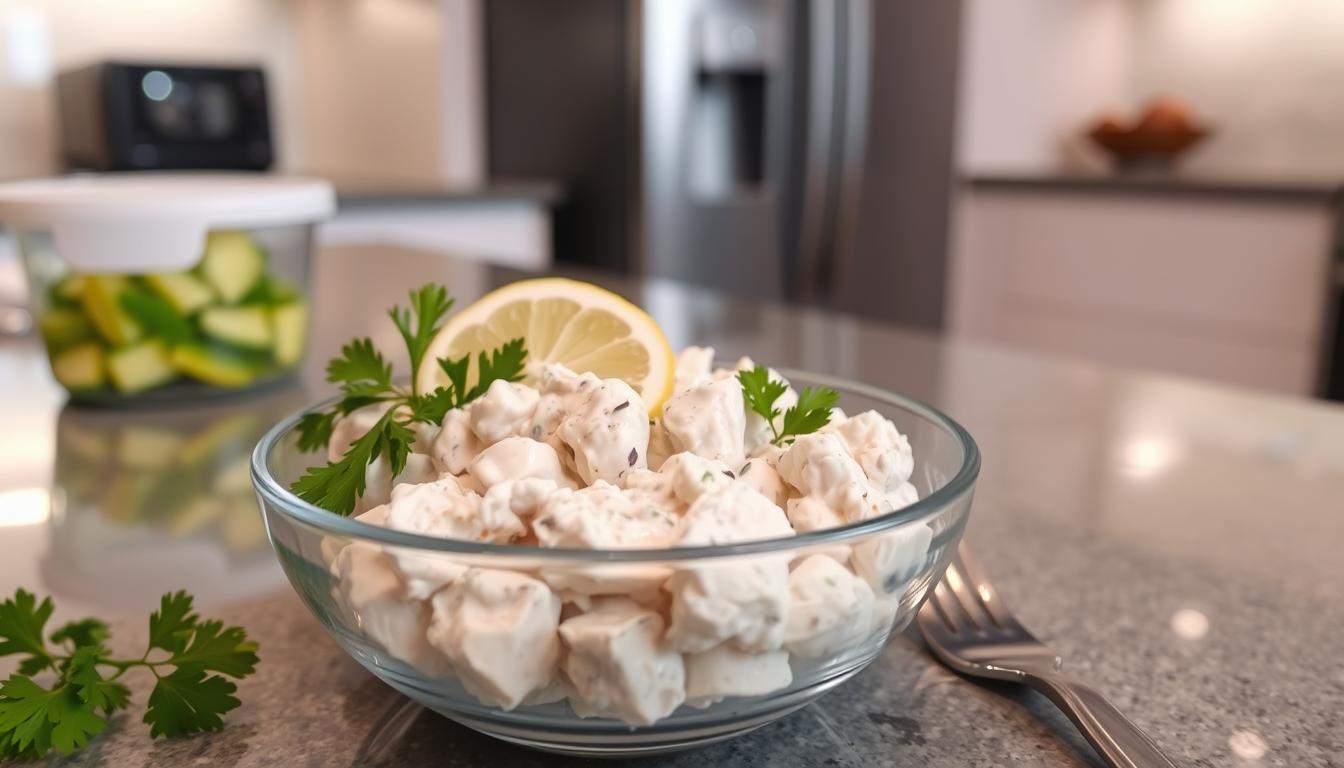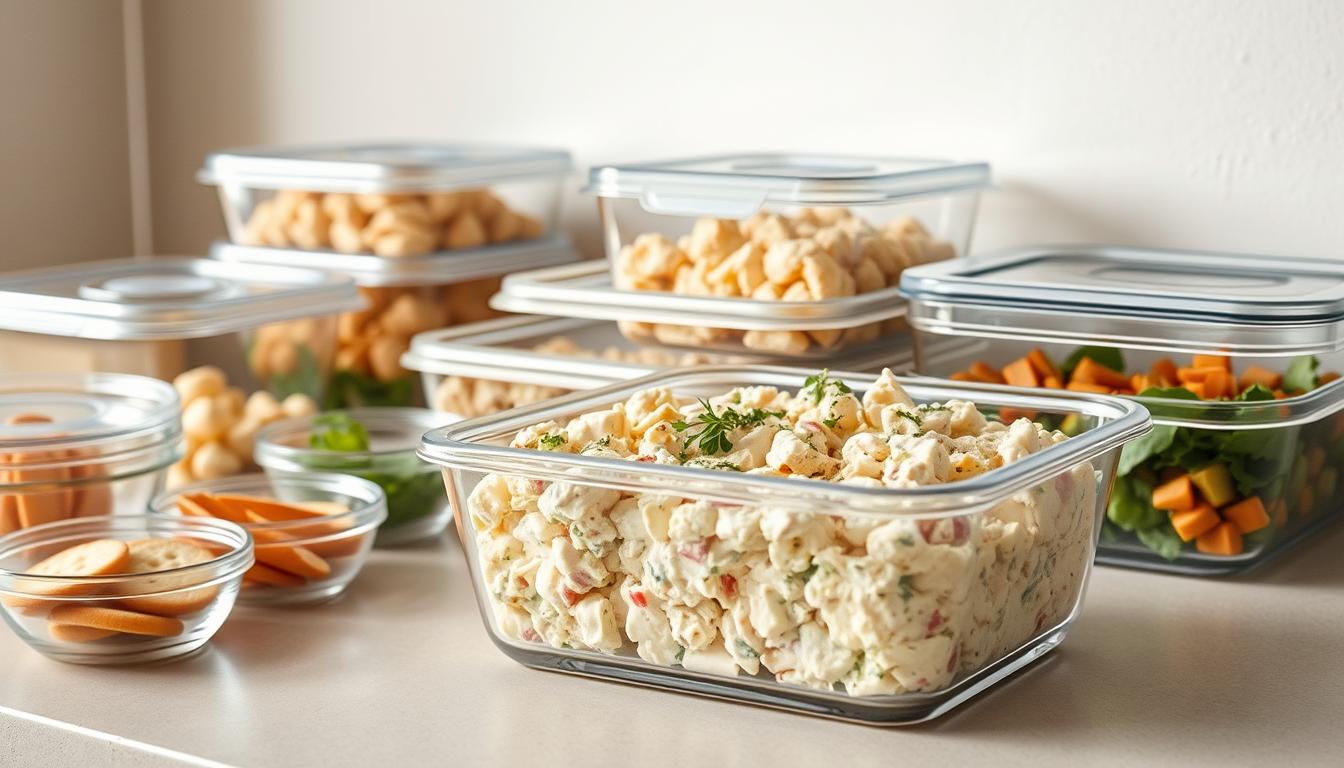Ever wondered if your homemade chicken salad is safe to eat after a few days? You’re not alone. Many of us have wondered if we should eat it or throw it away.

Knowing how to store chicken salad is key for safety. This article will show you how to keep it fresh longer. You’ll learn the best ways to store it in the fridge.
Key Takeaways
- Understand the importance of proper chicken salad storage.
- Learn the ideal refrigerator temperature for storing chicken salad.
- Discover how to handle and store chicken salad safely.
- Find out the signs of spoilage to watch out for.
- Get tips on maximizing the shelf life of your chicken salad.
The Basics of Chicken Salad Storage
Storing chicken salad right is key to keep it fresh and safe. You must know why it goes bad and how to store it well.
What Makes Chicken Salad Perishable
Chicken salad is a high-risk food because of its protein. This makes it a perfect place for bacteria to grow. Several things make it spoil faster.
Protein Degradation Process
The protein in chicken salad breaks down over time. This happens when it gets too hot or cold. It changes the texture and helps bacteria grow.
Bacterial Growth Factors
Bacteria love moist, rich foods like chicken salad. Things like temperature and how it’s handled affect how fast they grow. Proper handling and storage are critical to slowing down this process.
The Importance of Proper Storage
Storing chicken salad right is very important. It keeps the salad good and safe to eat. Storing it wrong can be very dangerous.
Food Safety Statistics
Many food illnesses come from bad handling and storage. This includes chicken salad.
Health Risks of Improper Storage
Chicken salad stored wrong can have harmful bacteria. This can cause food poisoning. Always store chicken salad the right way to avoid these dangers.
How Long Can You Keep Chicken Salad in the Refrigerator?
To keep chicken salad fresh, knowing how long to store it is key. The fridge life of chicken salad changes based on a few things. These include how you store it and the salad’s type.
USDA and FDA Guidelines
The USDA and FDA give rules for safe chicken salad storage. These rules are based on science. They aim to lower the risk of getting sick from food.
Official Recommendations
The USDA and FDA say chicken salad should stay in the fridge at 40°F (4°C) or colder. They suggest keeping it for 3 to 5 days.
Scientific Basis for Guidelines
The rules are made to slow down harmful bacteria like Salmonella and Campylobacter. Proper storage conditions help a lot in this fight.
Commercial vs. Homemade Chicken Salad
Whether it’s store-bought or homemade, chicken salad’s shelf life varies. Commercial salads often have preservatives to last longer.
Preservatives in Store-Bought Options
Commercial chicken salads might have preservatives like sodium benzoate or potassium sorbate. These help stop bacteria from growing. Always look at the ingredients for these.
Freshness Indicators for Homemade Versions
For homemade chicken salad, watch for signs of spoilage. Look for bad smells, a slimy feel, or mold. If you see any, throw it away.
| Type of Chicken Salad | Typical Shelf Life | Factors Affecting Shelf Life |
|---|---|---|
| Commercial | 5-7 days | Preservatives, Storage Conditions |
| Homemade | 3-5 days | Storage Conditions, Handling |
Factors Affecting Chicken Salad Shelf Life
Knowing what affects chicken salad’s shelf life is key. It keeps it fresh and safe to eat. Several things can change how long it stays good.
Ingredients That Spoil Quickly
The ingredients in chicken salad are very important. Some spoil faster than others.
Mayonnaise Concerns
Mayonnaise is often in chicken salad. But, it can grow bacteria if not stored right. Always check its expiration date and keep it cold.
Fresh Vegetables and Fruits
Fresh veggies and fruits make chicken salad taste better and healthier. But, they can also make it spoil faster. They add moisture and can have bacteria.
Temperature Considerations
Temperature is very important for chicken salad’s safety and quality.
Danger Zone Temperatures
Bacteria grow best between 40°F and 140°F. Keeping chicken salad out of this range is key to stop bacteria.
Refrigerator Temperature Fluctuations
Changes in fridge temperature can affect chicken salad. Make sure your fridge stays below 40°F.
Cross-Contamination Risks
Cross-contamination can harm chicken salad’s safety.
Handling Practices
Bad handling, like using dirty utensils, can contaminate chicken salad.
Storage Proximity to Other Foods
Keeping chicken salad near raw meats or fish increases cross-contamination risk.
| Factor | Impact on Shelf Life | Prevention |
|---|---|---|
| Mayonnaise | Can spoil if not stored properly | Check expiration date, store below 40°F (4°C) |
| Fresh Vegetables/Fruits | Can introduce moisture and bacteria | Use fresh ingredients, store properly |
| Temperature Fluctuations | Can allow bacterial growth | Maintain consistent refrigerator temperature |
Proper Refrigeration Techniques
Keeping your chicken salad fresh and safe is all about the right fridge settings. You need to focus on two things: the perfect fridge temperature and where to put it in the fridge.
Ideal Temperature Settings
Your fridge should be at 40°F (4°C) or colder. This stops bacteria from growing.
Checking Your Refrigerator Temperature
Use a fridge thermometer to check the temperature. Put it in the middle shelf and wait a bit before reading it.
Temperature Maintenance Tips
To keep the right temperature, don’t pack your fridge too full. This lets air move around. Also, clean your fridge often to keep the temperature steady.
Best Placement in Your Refrigerator
Where you put your chicken salad in the fridge matters. It should go in the coldest part.
Coldest Spots in Your Fridge
The coldest spot is usually at the fridge’s back bottom shelf or the bottom drawer. Use a thermometer to find the coldest spot in your fridge.
Avoiding Door Storage
The fridge door is the warmest because it opens and closes a lot. Don’t store chicken salad there. Put it in the coldest spot you found.
| Storage Location | Temperature | Suitability for Chicken Salad |
|---|---|---|
| Back of the bottom shelf | 38-40°F (3-4°C) | Yes |
| Middle shelf | 40-42°F (4-6°C) | Conditional |
| Refrigerator door | 42-45°F (6-7°C) | No |

Storage Containers Matter
The right storage container is key for keeping your chicken salad fresh and safe. You must pick a container that keeps the salad fresh.
Airtight Container Benefits
Airtight containers are great for keeping chicken salad fresh. They stop air, moisture, and bad stuff from getting in.
Preventing Moisture Loss
Airtight containers keep the salad moist. This is very important for salads with mayonnaise.
Limiting Bacterial Exposure
Airtight containers also stop bacteria from growing. This is very important for food safety.
Materials to Use and Avoid
The material of your container matters a lot. Different materials can affect how fresh and safe your salad stays.
Glass vs. Plastic Containers
Glass containers are great because they don’t hold smells or tastes. Plastic containers are handy but might not stop bacteria as well.
| Material | Non-Porous | Odor Retention |
|---|---|---|
| Glass | Yes | No |
| Plastic | No | Yes |
BPA and Food Safety Concerns
Some plastic containers have BPA, which can get into food. Using BPA-free containers is a good idea.
Signs Your Chicken Salad Has Gone Bad
Checking if chicken salad is bad isn’t just about the date. You need to look for signs it’s not good anymore. This is to keep you safe from getting sick.
Visual Indicators
First, look for changes in how it looks. These can tell you if it’s gone bad.
Color Changes to Watch For
Good chicken salad looks the same all over. But if it turns green or gray, it’s bad.
Mold Development Patterns
Mold looks like fuzzy spots. Seeing mold means it’s not safe to eat.
Smell Test
Smell is a simple way to check if chicken salad is fresh. It should smell nice.
Normal vs. Abnormal Odors
A bad smell means it’s gone bad. If it smells sour or strong, don’t eat it.
Detecting Subtle Changes
Some smells are hard to notice. If you’re not sure, it’s safer to throw it away.
Texture Changes
Texture is key to knowing if chicken salad is fresh. Any big change means it’s not good.
Sliminess and Moisture Issues
Too slimy or wet means it’s bad. Good chicken salad feels right.
When to Trust Your Instincts
If something feels wrong, even if you can’t say why, trust your gut. It’s better to be safe than sorry.
Different Types of Chicken Salad and Their Storage Times
Knowing about different chicken salads is key for keeping them fresh. The mix of ingredients and how you make it affects how long it stays good.
Mayonnaise-Based Chicken Salad
Mayonnaise chicken salads are creamy and tasty. But, mayonnaise can grow bacteria if not stored right.
Commercial vs. Homemade Mayo
Store-bought mayo has preservatives like vinegar or lemon juice. These help it last longer. Homemade mayo, without these, spoils faster.
Expected Shelf Life
Mayonnaise chicken salad can last 3 to 5 days in the fridge. But, it depends on the ingredients and how you store it.
Vinegar-Based Chicken Salad
Vinegar chicken salads are tangy and different. Vinegar’s acidity stops bacteria from growing.
Preservation Effects of Acidity
Vinegar keeps the salad fresh longer. It’s a natural way to preserve it.
Storage Advantages
Vinegar chicken salads last longer than mayo ones. They can stay fresh for up to 5 days or more.
Chicken Salad with Fruits and Nuts
Fruits and nuts make chicken salad taste better. But, they also change how long it stays fresh.
How Add-ins Affect Longevity
Fruits, like grapes or apples, make the salad last less long. They add moisture.
Special Storage Considerations
Keep chicken salads with fruits and nuts in airtight containers. Store them in the fridge at 40°F (4°C) or below.
Meal Prepping with Chicken Salad
Chicken salad is great for meal prep. It’s easy to make in big batches. You can store it in the fridge for days, perfect for lunches or snacks.
To keep it fresh, you need to store and handle it right.
Batch Preparation Strategies
Make chicken salad in batches to save time. This way, your meals will be the same every day. Think about the ingredients and how long they last.
Ingredient Separation Techniques
Keep ingredients that spoil fast, like herbs or mayonnaise, separate. Store them in different containers. Then, mix them just before you eat.
Assembly Timing
Make your chicken salad just before you eat. This stops it from getting soggy or bad. It’s key if you add nuts or fruits.
Portion Control for Freshness
Divide your chicken salad into parts to keep it fresh. The right containers and a rotation system help a lot.
Single-Serving Containers
Use single-serving containers to avoid mixing flavors. Choose ones that are airtight and won’t leak.
Rotation Systems
Use a rotation system to eat the oldest parts first. Label your containers with dates to remember.
| Storage Method | Freshness Duration | Tips |
|---|---|---|
| Airtight Containers | 3-5 days | Keep in the coldest part of the refrigerator. |
| Single-Serving Containers | 3-5 days | Label with dates for rotation. |

Can You Freeze Chicken Salad?
Freezing chicken salad can make it last longer. But, you must know how to freeze and thaw it right. This keeps it safe and tasty.
Freezing Methods
To freeze chicken salad well, think about the ingredients. Some freeze better than others.
Ingredients That Freeze Well
Mayonnaise and chicken usually freeze okay. But, their texture might change a bit.
Ingredients to Avoid Freezing
Celery and grapes don’t freeze well. They have too much water. This makes them taste bad when thawed.
Thawing Safely
When you want to eat the frozen chicken salad, thaw it safely. This stops bacteria from growing.
Refrigerator Thawing Process
Thawing in the fridge is the safest way. It lets the salad thaw slowly and keeps it cold.
Quality After Freezing
After thawing, the salad’s quality might change. It’s best to eat it right away. Don’t freeze it again.
| Ingredient | Freezing Compatibility | Thawing Quality |
|---|---|---|
| Mayonnaise | Good | Fair |
| Chicken | Good | Good |
| Celery | Poor | Poor |
Serving Refrigerated Chicken Salad Safely
To enjoy your chicken salad safely, follow these tips. Serving it right helps avoid food poisoning.
The Two-Hour Rule
The two-hour rule is simple. It says to keep perishable foods like chicken salad cold for less than two hours.
Temperature Monitoring
Monitor the temperature of your chicken salad. Use a food thermometer. It should be below 40°F (4°C) or above 140°F (60°C).
Using Ice Baths for Buffets
For buffets, use ice baths to keep chicken salad cool. This is great for big gatherings where the salad is out longer.

Picnics and Outdoor Events
At picnics or outdoor events, keep chicken salad cool. Use coolers with ice packs to keep it safe.
Cooler Packing Techniques
Pack your cooler right. Put ice packs at the bottom and sides. This keeps your food cool.
When to Discard Leftovers
If chicken salad has been out too long, throw it away. If it’s been more than two hours at room temperature, it’s not safe.
Conclusion
Storing chicken salad right is key to keeping it fresh and safe. Knowing how long it stays good in the fridge helps. This way, you can enjoy your meal without fear of getting sick.
To keep chicken salad fresh, use airtight containers. Keep the fridge at 40°F (4°C) or lower. Watch out for ingredients that spoil fast.
Check your chicken salad often for bad smells, slimy feel, or mold. Following these tips helps keep your chicken salad safe and tasty.
FAQ
How long can you keep chicken salad in the refrigerator?
The USDA and FDA say chicken salad can stay in the fridge for 3 to 5 days. But, it depends on how you store it and what’s in it.
What are the best practices for storing chicken salad?
Keep chicken salad in airtight containers. Make sure your fridge is at 40°F (4°C) or colder. Always check it for spoilage.
Can you freeze chicken salad, and if so, for how long?
Yes, you can freeze chicken salad. But, it might not taste as good as fresh. Frozen chicken salad can last 2 to 3 months. Use airtight containers or bags to keep it fresh.
How can you tell if chicken salad has gone bad?
Look for mold, sliminess, or color changes. Smell it to see if it smells off. If it feels too dry or slimy, it’s bad. If unsure, throw it away.
What are the risks of consuming spoiled chicken salad?
Bad chicken salad can make you sick. You might get nausea, vomiting, diarrhea, or stomach pain. For some, it can be very serious.
How can you preserve chicken salad in the fridge?
Store chicken salad in airtight containers. Keep it cold and check it often. You can also add vinegar to make it last longer.
